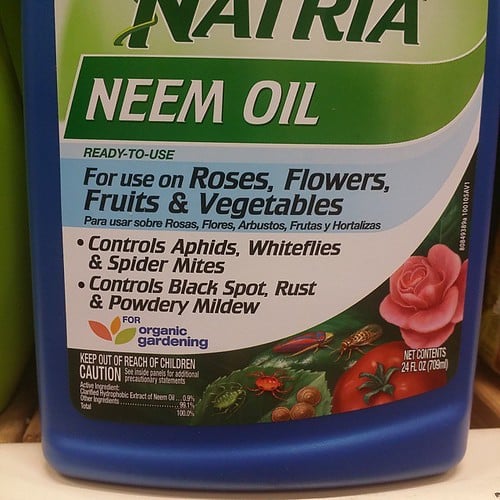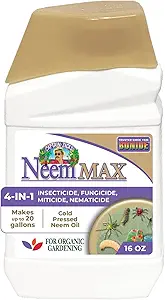Table of Contents
- Introduction
- History of Neem Oil in Agriculture
- Why Neem Oil Works as an Effective Fungicide
- Benefits of Using Neem Oil Over Synthetic Fungicides
- How to Use Neem Oil as a Fungicide
- Real-World Applications and Success Stories
- Products on the Market
- Conclusion
The natural world has, for eons, offered a plethora of solutions to many of the challenges we face. Among the myriad of botanical wonders, neem oil stands out as a versatile defender against pests and diseases. But what makes neem oil so special? And why has the term “neem oil as a fungicide” started echoing in the corridors of organic farming and gardening?
Neem oil, a vegetable oil pressed from the fruits and seeds of the neem tree (Azadirachta indica), has been used for centuries in traditional medicine, cosmetics, and, most notably, agriculture. When we delve deeper into its properties, the use of neem oil as a fungicide emerges as one of its predominant roles, ensuring plants remain robust and disease-free.
The Importance of Organic and Natural Fungicides
With the constant evolution of fungi and the rapid emergence of resistant strains, there’s a pressing need for sustainable and effective solutions. Synthetic fungicides, while effective, often come with a host of environmental and health-related concerns. They can contaminate soil, water sources, and even the very produce we consume. Moreover, over-reliance on these synthetic agents can lead to fungi developing resistance, making them even harder to control in the long run.
Enter natural fungicides like neem oil. These solutions, derived from nature, offer a gentler, eco-friendlier alternative. They not only help in combating fungal infections but also ensure the safety of beneficial insects, the environment, and, most importantly, us, the consumers.
History of Neem Oil in Agriculture
The legacy of neem is deeply rooted in ancient cultures. Originating in the Indian subcontinent, the neem tree has been dubbed “The Village Pharmacy” owing to its vast medicinal properties. Every part of this miraculous tree, from its leaves to its seeds, has found a purpose.
Origin and Extraction of Neem Oil
The seeds of the neem tree are the primary source of neem oil. They are cold-pressed to extract the oil, much like olive or avocado oils. This process ensures that the beneficial compounds are preserved, making the oil potent against a range of pests and fungal pathogens.
Traditional Use in Ancient Cultures
Historical records and ancient scriptures from India attest to the integral role of neem in agriculture and medicine. Farmers of yore recognized the tree’s protective qualities, using its leaves as a natural pest repellent. Neem leaves were often stored with grains to prevent insect infestation. As knowledge about the oil’s properties grew, its application expanded, eventually cementing its role as an indispensable tool in organic farming.
Why Neem Oil Works as an Effective Fungicide
In the world of natural remedies, not all solutions are made equal. Yet, time and time again, neem oil proves its mettle as a formidable foe to fungal infections. But what gives neem oil its anti-fungal prowess?
Composition of Neem Oil: Azadirachtin and Other Compounds
At the heart of neem oil’s effectiveness lies a cocktail of compounds that work in tandem to ward off pests and fungi. Chief among these is azadirachtin. This compound disrupts the life cycle of pests and hampers the growth of fungi, ensuring plants remain unscathed.
Besides azadirachtin, neem oil boasts over 100 triterpenoids, limonoids, and other bioactive compounds. These compounds synergize to deliver a one-two punch, repelling pests and arresting fungal growth.
Mode of Action Against Fungi and Their Spores
Neem oil doesn’t just deter fungi; it stops them in their tracks. When fungi come into contact with neem oil, the oil’s bioactive compounds impair their ability to grow and reproduce. Furthermore, the oil forms a protective barrier on plants, preventing fungal spores from germinating and taking hold.
Comparison with Synthetic Fungicides
While synthetic fungicides often target specific fungi, neem oil adopts a broader approach. Its multi-faceted mode of action ensures it remains effective against a wide spectrum of fungal pathogens. Moreover, unlike many synthetic fungicides, neem oil’s biodegradable nature means it leaves no harmful residues, making it a sustainable choice for both plants and the planet.
Benefits of Using Neem Oil Over Synthetic Fungicides
In today’s eco-conscious era, the swing towards natural, sustainable solutions is more than just a trend—it’s a necessity. As we’ve established, neem oil stands tall as an effective fungicide, but its benefits don’t stop there.
Safety for Beneficial Insects and the Environment
One of neem oil’s standout features is its selective nature. While it wards off pests and fungi, it does so without harming beneficial insects like bees, butterflies, and ladybugs. This selective toxicity ensures that while harmful organisms are kept at bay, essential pollinators and predators of pests continue to thrive, maintaining a balanced ecosystem.
Non-toxicity to Humans and Pets
Unlike many synthetic fungicides that pose health risks to humans and animals, neem oil is generally safe. When used as directed, it poses minimal risks, making it an ideal choice for households with children and pets. However, as with all products, it’s always advised to keep it out of reach of children and to use it judiciously.
Resilience Against Fungi Resistance
Over time, fungi, like many organisms, can develop resistance to treatments, especially synthetic ones. However, due to its multi-pronged mode of action, fungi find it challenging to develop resistance against neem oil, ensuring its efficacy in the long run.
How to Use Neem Oil as a Fungicide
While the benefits and properties of neem oil are undoubtedly impressive, they’re only as good as the application method. Using neem oil effectively requires a blend of precision, consistency, and knowledge about the plant’s needs.
Preparation of the Neem Oil Solution
The potency of neem oil necessitates its dilution before application. A common recommendation is to mix 2 tablespoons of neem oil with a gallon of water. However, always refer to the label of your specific product, as concentrations may vary.
Ensuring Even Application
When using neem oil as a fungicide, coverage is crucial. Using a sprayer, ensure that the solution reaches all parts of the plant, especially the undersides of leaves where fungi and pests often reside. A thorough application ensures that the plant receives maximum protection.
Best Time for Application
Neem oil, when exposed to direct sunlight, can lose some of its effectiveness. Therefore, the best times to spray are during the early morning or late afternoon. Furthermore, consider the weather forecast; rain shortly after application can wash away the oil, rendering it less effective.
Frequency of Use
Regular application of neem oil is key to its efficacy. For preventive measures, applying once every 7-14 days can suffice. However, if dealing with an active fungal infection, consider increasing the frequency to every 5-7 days until the issue is resolved.
Real-World Applications and Success Stories
While the science and guidelines provide a compelling narrative, real-world applications and success stories truly illuminate the impact of using neem oil as a fungicide.
Organic Farms Making the Shift
Across the globe, many organic farms have transitioned to using neem oil as their primary fungicidal agent. Besides the evident benefits to the crops, these farms report healthier soil profiles, increased beneficial insect activity, and even higher yields.
Home Gardeners Finding Success
Home gardening enthusiasts too have shared myriad success stories. From saving a prized rose bush from a relentless fungal attack to ensuring bountiful vegetable harvests, the tales of triumph underscore the versatility and potency of neem oil.
Greenhouses Opting for Sustainability
Given the controlled environment in greenhouses, fungal outbreaks can be particularly devastating. Many greenhouse operators, recognizing the risks of synthetic fungicides, have successfully adopted neem oil as a safer, more sustainable alternative, safeguarding both their plants and their patrons.
Best Neem Oil Fungicides of 2023
As the popularity of neem oil as a fungicide grows, so does the number of products available. To help you navigate this plethora, we’ve curated a list of some top-quality neem oil products known for their efficacy.
Garden Safe Neem Oil Extract Concentrate
Renowned for its high-quality ingredients, Garden Safe’s Neem Oil Extract Concentrate has become a favorite among both amateur and professional gardeners. Its formula is particularly effective against a broad spectrum of fungal pathogens.
Bonide (BND022) – Ready to Use Neem Oil
For those seeking a ready-to-use solution, Bonide offers a pre-diluted neem oil formula. It’s ideal for quick applications and is known for its consistent results in combating fungal infections.
Southern Ag 08722 Triple Action Neem Oil
Southern Ag’s Triple Action Neem Oil is lauded for its triple threat against pests, diseases, and mites. Its high azadirachtin content ensures that it packs a punch, making it a potent fungicide and insecticide.
Natura Bona Pure Organic Neem Oil
For the purists out there, Natura Bona offers a 100% pure, cold-pressed neem oil. Its unrefined nature ensures maximum efficacy, making it a top pick for those seeking an organic solution to fungal woes.
Conclusion: The Natural Power of Neem Oil
The journey of neem oil, from its roots in ancient Ayurveda to its modern-day prominence, is a testament to its enduring efficacy. As we grapple with an array of environmental challenges, turning to nature’s solutions seems not just wise, but imperative.
Neem oil as a fungicide is more than just a trend; it’s a potent, sustainable, and versatile remedy. Whether you’re an avid gardener battling fungal foes or an organic farm seeking sustainable solutions, neem oil emerges as a powerful ally. As with any product, judicious use, regular application, and adherence to guidelines ensure that the wonders of neem oil are fully harnessed, letting your plants thrive and bloom in all their glory.



